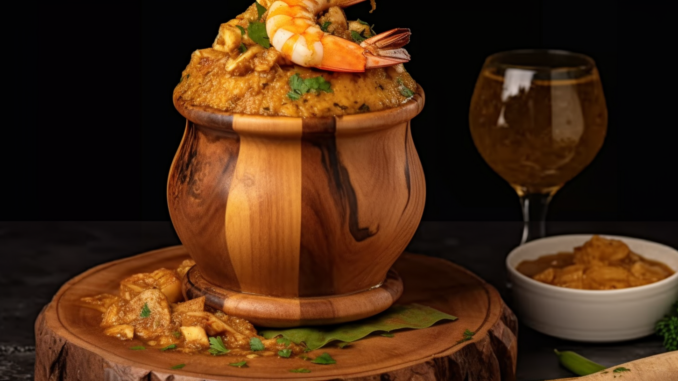
Mofongo, a fried plantain-based dish, holds a special place in the hearts and palates of Puerto Ricans. This iconic culinary creation, bursting with flavors and textures, is a testament to the rich cultural tapestry that defines Puerto Rican cuisine. While similar dishes like fufu de plátano in Cuban cuisine and Mangú in the Dominican Republic share some similarities, mofongo has its own unique character that sets it apart.
Traditionally, mofongo is made by frying green plantains until they develop a golden hue. These fried plantains are then meticulously mashed together with broth, garlic, olive oil, and pork cracklings or bacon bits, resulting in a delightful blend of savory goodness. However, it’s worth noting that mofongo can also be prepared using fried yuca or breadfruit, offering delicious alternatives to the classic version. The dish often serves as a vessel for a variety of fillings such as vegetables, chicken, crab, shrimp, or beef. When accompanied by fried meat and chicken broth soup, mofongo becomes a truly satisfying meal.
Although there is some debate about its origins, the African influence on mofongo is widely acknowledged. Dominican chefs suggest that mofongo in Dominican cuisine can be traced back to Puerto Rico. However, scholarly research indicates that the dish has its roots in Africa, specifically a variant of a dish called “fufu.” Africans brought fufu, made from various starchy vegetables, to the Caribbean during the era of Spanish colonization. The Dominican Republic, Cuba, and Puerto Rico were among the Spanish New World colonies where Africans introduced this culinary tradition.
While both fufu and mofongo involve cooking and mashing plantains, their methods and final results differ. In mofongo, unripened plantains are fried before being mashed, creating a unique flavor profile. In contrast, fufu is made using either green or semi-ripe plantains that are boiled and then mashed. The seasoning of both fufu and mofongo occurs after the plantains are cooked and mashed, allowing the flavors to meld and develop.
Mofongo’s popularity has spread far beyond Puerto Rico, captivating the taste buds of people worldwide. It stands as a symbol of Puerto Rican culinary heritage and the diversity that shaped it. From the African roots of fufu to the modern-day variations enjoyed in Puerto Rican households, mofongo embodies a fusion of cultures and flavors.
Today, mofongo continues to evolve, adapting to the creativity and preferences of those who prepare it. The dish’s versatility allows for endless experimentation, ensuring that each mofongo experience is a delightful surprise. Whether enjoyed with a succulent filling of beef, chicken, or seafood, or accompanied by aromatic sauces, mofongo never fails to satisfy cravings and leave a lasting impression.
Ya sabes, mofongo represents the essence of Puerto Rican cuisine, embracing its African roots while integrating local ingredients and culinary techniques. Its journey from the shores of Africa to the vibrant kitchens of Puerto Rico is a testament to the interconnectedness of cultures and the transformative power of food. So, the next time you savor a plate of mofongo, take a moment to appreciate the history and cultural legacy encapsulated within this beloved Puerto Rican dish.
